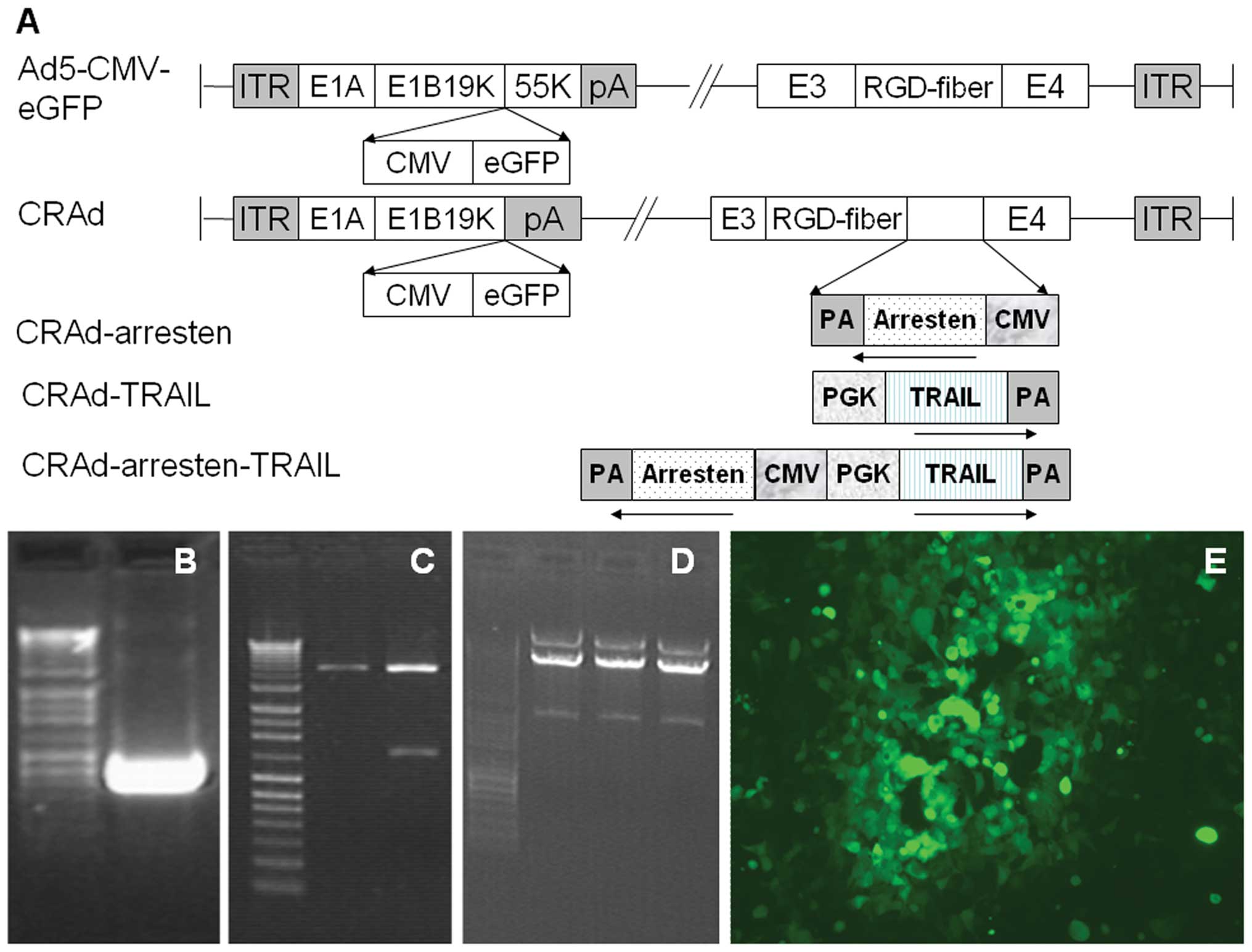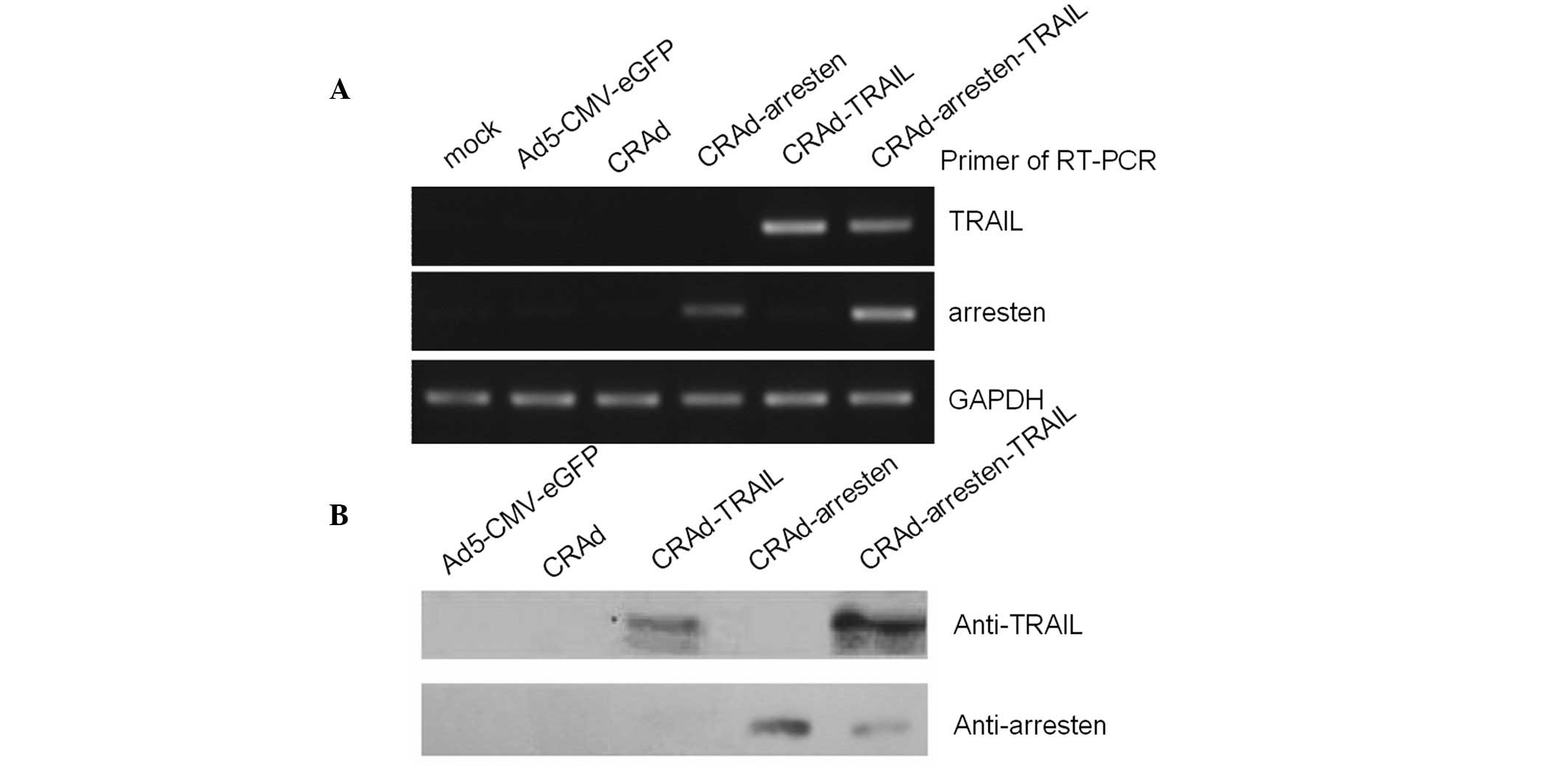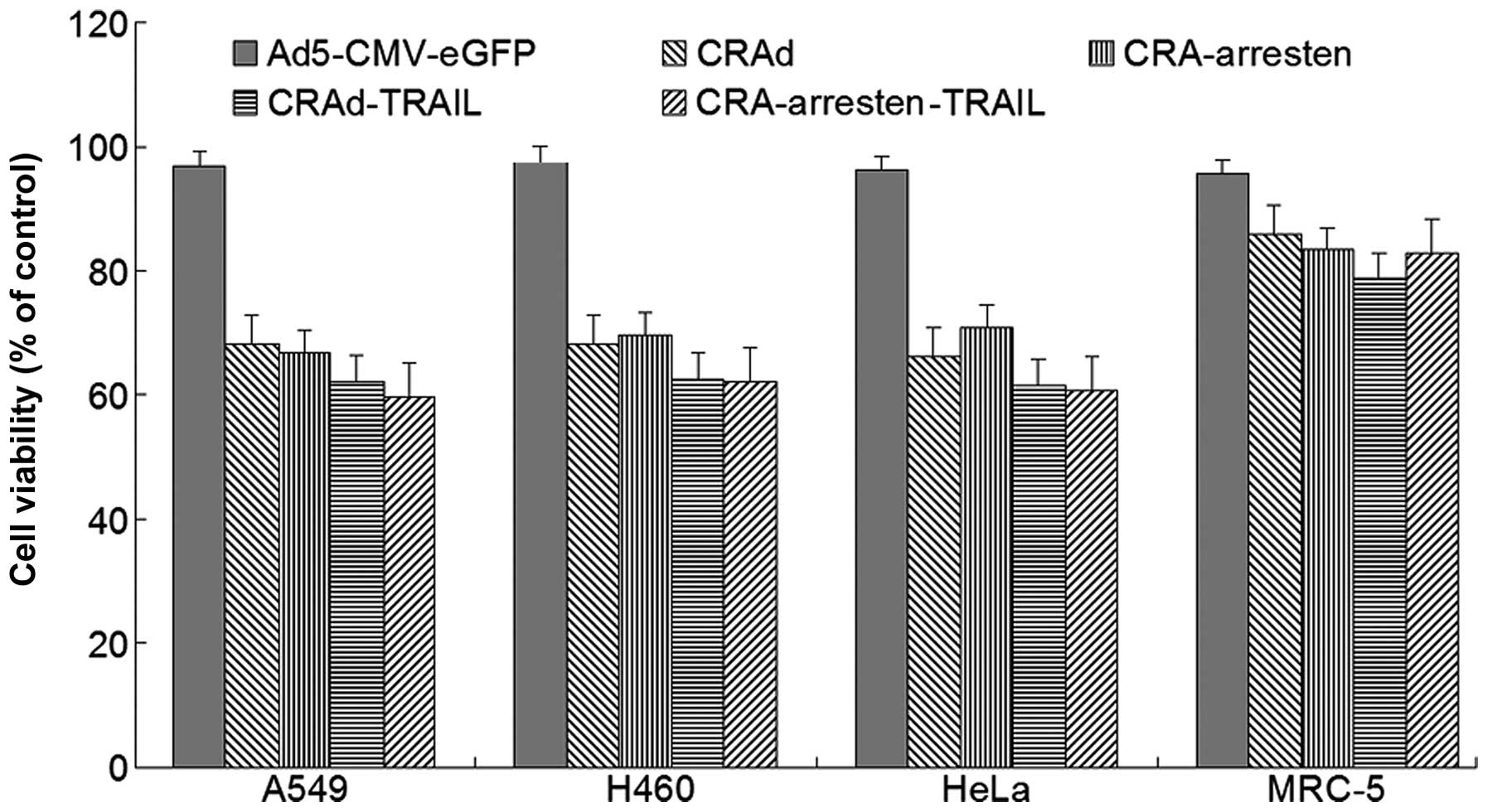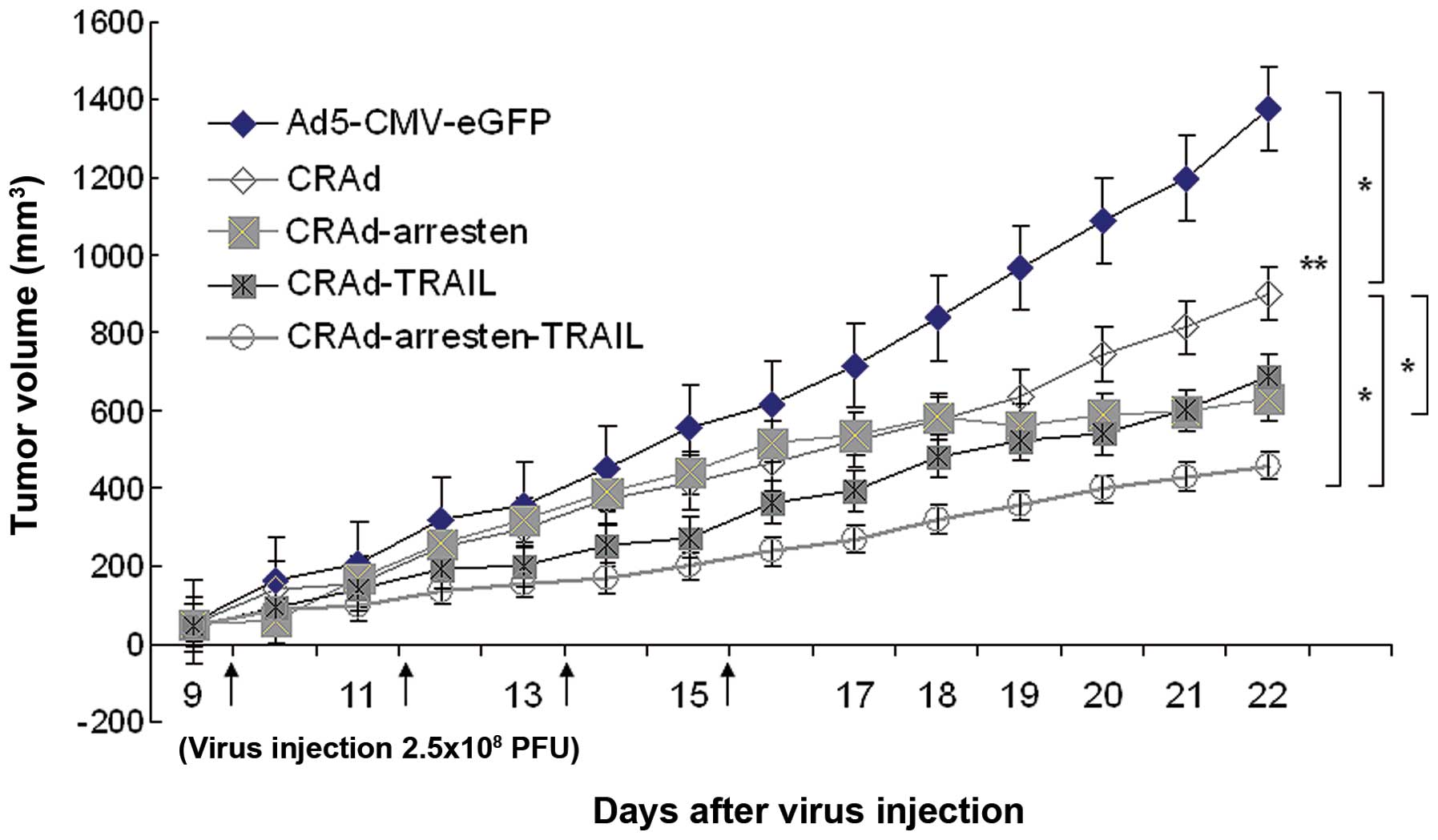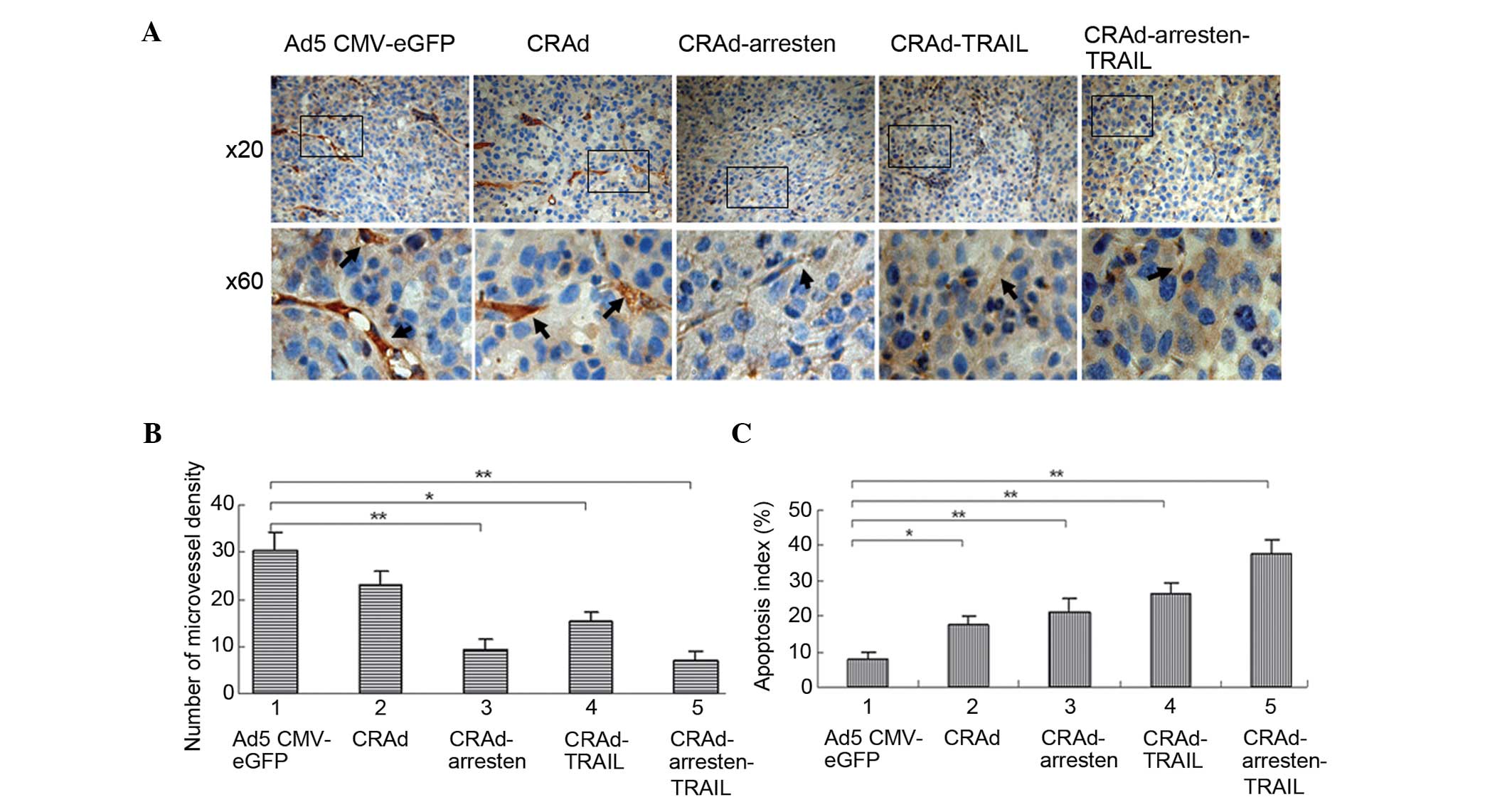Conditionally replicating oncolytic adenoviral vector expressing arresten and tumor necrosis factor-related apoptosis-inducing ligand experimentally suppresses lung carcinoma progression
- Authors:
- Published online on: April 16, 2015 https://doi.org/10.3892/mmr.2015.3624
- Pages: 2068-2074
Abstract
Introduction
Lung carcinoma (LC), is the most common type of cancer and the leading cause of cancer-related mortality worldwide (1). Currently available treatments are ineffective in 60–70% of patients with LC (1,2). LC is remarkably resistant to chemotherapy and radiotherapy (2). Therefore, novel therapeutic approaches to LC are required.
Adenoviral vectors may be produced in high titers, generally do not integrate into DNA and exhibit low pathogenicity in humans. Therefore, they are commonly used in cancer gene therapy (3,4). However, adenoviral vectors are rarely capable of successful amplification in tumor cells, which limits their therapeutic efficacy in cancer (4). Conditionally replicating adenovirus (CRAd; oncolytic adenovirus) is currently used for the treatment of solid tumors (5). Oncolytic therapy uses viruses that are tumor-specific and cause the proliferation of progeny viruses in neighboring tumor cells, eventually resulting in lysis of these cells.
CRAds are currently separated into three categories: A tumor-specific adenoviral vector that uses tumor-specific promoters (such as telomerase) to express the early region 1A (E1A) gene, which is amplified in tumor cells (6,7); adendovirus 5 (Ad5) Δ-24 vector, which exhibits a 24 base pair (bp) deletion in the Ad5 E1A conserved domain 2 (CR2) region and is replicated in tumor cells exhibiting retinoblastoma protein dysfunctions (8,9); and ONYX-015, which lacks the E1B 55 kilodalton (kDa) gene, dl1520, and is replicated in p53-deficient tumor cells (10,11).
ONYX-015 exhibited positive experimental results, with the ONYX-015 vector being able to selectively replicate in or cause lysis of p53-deficient tumor cells in in vitro and in vivo experiments (12,13). However, the outcomes of clinical trials that used ONYX-015 as a monotherapy were found to be less positive (14,15). ONYX-015 is therefore combined with therapeutic genes, such as canstatin and mutant K5 genes, in order to overcome this limitation. Antitumor gene therapy makes use of angiogenesis inhibitor genes (16,17). Arresten is an angiogenesis inhibitor, which may help to inhibit tumor cell growth (18).
In the present study, Ad5 E1B 55 kDa-deficient CRAd was used in order to investigate its potential in the treatment of LC. Two expression cassettes that express arresten and tumor necrosis factor-related apoptosis-inducing ligand (TRAIL) were inserted into the fiber and the putative early region 4 (E4) of CRAd in order to investigate the synergistic mechanisms of the two genes and their potential in the treatment of LC.
Materials and methods
Cell cultures
Cell lines were maintained in a humidified 37°C atmosphere at 5% CO2. The following cell lines were purchased from the Shanghai Cell Collection Center (Shanghai, China), A549 (human lung adenocarcinoma), NCI H460 (human lung large cell carcinoma), and HeLa and MRC-5 (healthy human lung cells). The HEK293 human embryonic kidney cell line was purchased from the American Type Culture Collection (ATCC, Manassas, VA, USA). Cells were maintained in Dulbecco’s modified Eagle’s medium or RPMI 1640 medium (Gibco Life Technologies, Carlsbad, CA, USA) supplemented with 10% heat-inactivated fetal bovine serum (Hangzhou Sijiqing Co. Ltd., Hangzhou, China), 250 U/ml penicillin and 250 µg/ml streptomycin (North China Pharmaceutical Co., Ltd., Shijiazhuang, China).
Construction of adenovirus transfer plasmids
The human arresten and TRAIL genes were amplified using polymerase chain reaction (PCR) from a human cDNA library (Agilent Technologies, Inc., Santa Clara, CA, USA). The following primers were used: Forward: 5′-aatcgatatgtctgttgatcacggcttc-3′ and reverse: 5′-atctagattatgttcttctcatacagac-3′ for arresten (with the restriction site Cla I and the initiation codon atg) and forward: 5′-aatcgatatggctatgatggaggt-3′ and reverse: 5′-atctagattatgttcttctcataca-3′ for TRAIL (with the restriction site Xba I). Protocols for PCR and cloning into the shuttle plasmid, pAd5-cytomegalovirus-(CMV) and pAd5-phosphoglycerate kinase 1-(PGK) were performed according to the methods described previously (19). Following digestion and sequencing of the amplified fragments, the shuttle plasmid was linearized with Pme I, and then transformed into Escherichia coli BJ5183-Ad Easy-1 (Agilent Technologies, Inc.) using electroporation (Multiporator; Eppendorf, Hamburg, Germany).
The plasmids were termed pAd-arresten and pAd-TRAIL, and their identifications were confirmed using kanamycin (Amresco LLC, Solon, OH, USA) selection and restriction digestion. The recombinant pAd-arresten and pAd-TRAIL were linearized with Pme I and transfected into HEK293 cells in order to form CRAd-arresten, CRAd-TRAIL and CRAd-arresten-TRAIL (Fig. 1).
Adenoviruses were detected by observation of a cytopathic effect using a fluorescence microscope (Observer Z1; Carl Zeiss AG, Jena, Germany), which is a routine method to detect the efficiency and activity of adenoviruses. Viruses were propagated in HEK293 cells, purified using ultracentrifugation in a cesium chloride (Sigma-Aldrich, St. Louis, MO, USA) gradient and subjected to dialysis in virus dialysis buffer (10 mM tris-HCl, pH 8.0; 2 mM MgCl2; 4% sucrose) four times for 1 h each time. Adenoviral functional titers were determined using a plaque assay of the HEK293 cells (19). Titers of the viruses were measured using a standard end point dilution assay, as described previously (19). Replication-deficient adenovirus-expressing reporter with enhanced green fluorescent protein (eGFP) with an RGD modification in the HI loop (Ad5-CMV-eGFP) from stock (Agilent Technologies, Inc.) was used as the negative control.
Reverse transcription-PCR (RT-PCR) analysis
Total RNA was extracted using TRIzol® (Invitrogen Life Technologies, Shanghai, China) from A549 human lung adenocarcinoma cell lines infected with the five adenoviruses and treated with DNase I (Takara Bio, Inc., Otsu, Japan; 0.2 U/µl working concentration). First strand cDNA was generated from 1 µg of RNA using an RNA LA PCR™ (AMV) kit (Takara Bio, Inc.). PCR was conducted using the following primers: Forward: 5′-acgggggaaaacataagacc-3′ and reverse: 5′-tggcgcacttctaaactcct-3′ for arresten; forward: 5′-acgacaaacaaatggtccaa-3′, and reverse: 5′-actaaaaaggccccgaaaaa-3′ for TRAIL gene; and forward: 5′-ggccaaggtcatccatgacaac-3′ and reverse: 5′-tcccgttcagctcagggatgac-3′ for GAPDH, which was used as a reference gene. PCR conditions consisted of an initial denaturation step for 5 min at 94°C, followed by 30 cycles of amplification (denaturation for 30 sec at 94°C, annealing for 30 sec at 55°C and extension for 30 sec at 72°C) and a final extension for 10 min at 72°C. PCR products (6 µl) were electrophoresed on 15g/l agarose gels (Invitrogen Life Technologies) in order to visualize cDNA products.
Western blot analysis
Following 48 h of infection with one of the five adenoviruses (CRAd, CRAd-arresten, CRAd-TRAIL, CRAd-arresten-TRAIL or the negative control, Ad5-CMV-eGFP, the infected A549 cell lines were harvested and total protein was extracted using a lysis buffer. Protein concentrations were measured using a protein assay kit (Bio-Rad Laboratories, Hercules, CA, USA). Total protein (20 µg) was separated on a 12% SDS-polyacrylamide gel (Amresco LLC) and transferred to a polyvinylidene fluoride membrane (GE Healthcare Bio-Sciences, Pittsburgh, PA, USA). Standard western blotting was conducted using polyclonal rabbit antibodies against human arresten (1:1,000; cat. no. PB0126) and TRAIL (1:500; cat. no. BA1446), and a secondary antibody (horseradish peroxidase-conjugated goat anti-rabbit IgG; cat. no. BA1055, Wuhan Boster Biological Technology, Ltd., Wuhan, China). Cells were washed three times with phosphate-buffered saline and Tween-20 (PBS-T) and bands were visualized using an enhanced chemiluminescence western blotting kit (EMD Millipore, Billerica, MA, USA).
Virus cytotoxicity was measured using a 3-(4,5-dimeth-ylthiazol-2-yl)-2,5 diphenyl tetrazolium bromide (MTT) assay. Cells were seeded in 96-well tissue culture plates (2×103 cells/well). Following exposure to adenoviruses for 24, 48 or 72 h (with five multiplicities of infection), 20 µl of MTT solution (Sigma-Aldrich; 2 mg/ml) was added. Subsequently the plates were incubated at 37°C for 4 h. The supernatants were replaced with acid isopropyl alcohol (Tianjin Chem Co., Ltd., Tianjin, China) in order to dissolve the solid product. The absorbance at 570 nm was measured using a microplate reader (Bio-Rad Laboratories). Experiments were repeated three times.
Animal experiments
Mice received care in compliance with the guidelines for the care and use of laboratory animals in research (20). Experiments were approved by the Ethics Committee of Shaanxi Normal University (Xi’an, China). A total of 30 female Balb/c nude mice, aged 4–6 weeks were obtained from the Animal Research Committee of the Institute of Biochemistry and Cell Biology (Shanghai, China). A xenograft tumor model was established using subcutaneous injections of A549 cell lines (2×106/ml) into the right flanks of the mice. Once the tumors had attained a size of 80–100 mm3, mice were randomly assigned one of five groups: Ad-CMV-eGFP (negative control), CRAd, CRAd-arresten, CRAd-TRAIL or CRAd-arresten-TRAIL. Mice were intratumorally injected with (5×108 plaque-forming unit) plaque-forming unit in 100 µl PBS and tumor size was measured, everyday for a period of eight days. Tumor sizes were measured using a caliper and tumor volume was calculated as length × width2/2 = tumor volume (mm3). At the end of the experiment, the mice were sacrificed by etherization and the tumors were resected in order to conduct immunohistochemical analysis.
Immunohistochemical analysis
Tumor tissues removed from treated mice were fixed in 10% buffered formalin (Tianjin Chem Co., Ltd.), dehydrated using gradient alcohols and embedded in paraffin. Serial sections (4- µm) were prepared and stained with hematoxylin and eosin (H&E). An ABC staining system kit (sc-2019; Santa Cruz Biotechnology, Inc., Dallas, TX, USA) was used in order to perform immunohistochemical analysis. Sections were washed with PBS and treated with 1% hydrogen peroxide for 20 min in order to inactivate the endogenous peroxidase. Subsequently, the sections were blocked using a blocking serum (Zhongshan Golden Bridge Biotechnology Co., Ltd., Beijing, China). Intratumoral microvessels were stained using a monoclonal rat anti-mouse antibody against the cluster of differentiation 31 (CD31; sc-71871; 1:200; Santa Cruz Biotechnology, Co., Ltd.) antigen in order to measure intratumoral microvessel density (MVD). The number of microvessels was counted from ten randomly selected visual fields (x400) using a light microscope (Observer Z1) and MVD was calculated using the Weidner standard of scoring (19). Steps were performed according to the manufacturer’s instructions. H&E was used as a counterstain.
A terminal deoxynucleotidyl transferase-mediated deoxynucleotide triphosphate-biotin nick end-labeling (TUNEL) assay
A TUNEL assay was performed in order to detect the presence of apoptotic cells, according to the manufacturer’s instructions (Nanjing, Keygen Biotech Co. Ltd., Nanjing, China). Apoptotic cells were counted on ten randomly selected visual fields (x400) using a light microscope. The apoptotic index was calculated using the formula: Apoptotic index = (total number of apoptotic cells/total number of cells) × 100.
Statistical analysis
Data are presented as the mean ± standard deviation. Unpaired student’s t-test and one-way analysis of variance were conducted in order to assess significant differences between groups. In all cases P<0.05 was considered to indicate a statistically significant difference.
Results
Gene cloning and the construction of four oncolytic adenoviruses
A schematic diagram of the five adenoviruses, including Ad5-CMV-eGFP (negative control), CRAd, CRAd-Arresten, CRAd-TRAIL and CRAd-Arresten-TRAIL is shown in Fig. 1A. The E1B 55 kDa fragment was deleted from the CRAd adenovirus. For the CRAd-arresten, CRAd-TRAIL or CRAd-arresten-TRAIL adenoviruses, the regions between fiber and E4 were replaced by one or two gene expression cassettes derived from CMV or PGK promoters (Fig. 1A).
Arresten cDNA (712 bp) was obtained using PCR amplification (Fig. 1B). The amplified fragment was inserted into a shuttle vector, downstream of the cytomegalovirus promoter using ligation and then confirmed using digestion with Hind III. A 1,300 bp fragment was released from shuttle-CMV ligated with arresten, by contrast, no fragment was released from shuttle-CMV without arresten (Fig. 1C). The resultant plasmid was referred to as shuttle-CMV-arresten, which was identified using DNA sequencing (21).
The protocols for TRAIL gene cloning and for the construction of the oncolytic adenovirus CRAd-TRAIL are similar to those of CRAd-Arresten (21).
Antitumor efficacy of CRAd with dual expression of TRAIL and arresten in vitro
In order to examine the expression patterns of the infected cells, total RNA was extracted from A549 cell lines infected with the five adenovirus vectors. RT-PCR assays were performed and the results suggested that arresten (217 bp) was expressed in CRAd-arresten- and CRAd-arresten-TRAIL-infected A549 lung carcinoma cells. By contrast it was not expressed in Ad5-CMV-eGFP-(negative control), CRAd- or CRAd-TRAIL-infected A549 cells. TRAIL was expressed in CRAd-TRAIL- and CRAd-arresten-TRAIL-infected A549 cells. By contrast, TRAIL was not expressed in Ad5-CMC-eGFP- (negative control), CRAd- or CRAd-arresten-infected A549 cell lines (Fig. 2A).
Western blot analysis was also performed. Anti-arresten was detected in CRAd-arresten- and CRAd-arresten-TRAIL-infected A549 cells (Fig. 2B). Anti-TRAIL was detected in CRAd-TRAIL- and CRAd-Arresten-TRAIL-infected A549 cells. Anti-arresten and anti-TRAIL were not detected in Ad5-CMV-eGFP- or CRAd-infected A549 cell lines.
The influence of the viruses on cell viability was evaluated using an MTT assay (Fig. 3). The results of the present study demonstrated that cell proliferation was significantly inhibited following infection with the CRAd adenoviruses compared with the cells treated with the control virus (P<0.01). The results also suggested that CRAd viruses are capable of replicating in tumor cells but not in healthy cells (MRC-5 cell line). Furthermore, A549 cell proliferation was inhibited to a greater degree following infection with CRAd-arresten ssssand CRAd-TRAIL, which may contribute to the replication of these viruses in cancer cells. Cells infected with CRAd-Arresten-TRAIL exhibited the lowest percentage cell viability. However, there were no significant differences in cell viability among the CRAd virus infected groups (P>0.05).
Lung cancer xenografts
The antitumor effects of adenoviruses were analyzed in vivo using A549 cancer subcutaneous xenografts. Tumor growth was significantly inhibited following infection with CRAd, CRAd-arresten, CRAd-TRAIL and CRAd-arresten-TRAIL adenoviruses, compared with that of the control group (Fig. 4). Tumor growth in mice infected with the four CRAd adenoviruses was slower than that in mice infected with the control adenovirus (Ad5-CMV-eGFP infected cells).
Following four injections of CRAd-arresten, tumor growth ceased on day 16 (Fig. 4). In addition, on day 22 tumor volumes in samples treated with CRAd-arresten (tumor volume 629.75±109.57 mm3) were significantly smaller than those in the control group (control cells; 1,477.38±110.23 mm3; P<0.01) and than those in the CRAd-infected group (902.44±179.61 mm3; P<0.05).
Mouse mortality was observed in the control group (Ad5-CMV-eGFP) on day 19. Mortality was observed in the CRAd-infected group on day 21. By contrast, there were no mortalities in mice infected with CRAd-arresten-TRAIL. The causes of mouse mortality were due to heavy tumor burden and consequent organ failure or cancer cachexia. Autopsies were performed and no evidence of tumor metastasis was observed.
In order to measure angiogenesis and the presence of apoptotic tumor cells, microvessel density (MVD) and TUNEL analyses were conducted. Immunostaining with anti-CD31 antibody (Fig. 5A) followed by quantification using MVD (Fig. 5B), suggested that MVD in the CRAd-arresten-TRAIL group (6.7±1.4; P<0.01), CRAd-arresten group (8.6±1.8; P<0.01) and CRAd-TRAIL-group (15.4±1.3; P<0.05) was significantly lower, as compared with that of the control virus infected group (Ad5-CMV-eGFP; 29.6±3.4).
TUNEL staining followed by quantification (Fig. 5C) suggested that the apoptotic indices in the CRAd-infected groups (17.9±2.9%, 21.5±3.2% and 24.6±3.7% and 37.7±3.3% in the CRAd, CRAd-arresten and CRAd-arresten-TRAIL infected A549 cell line groups, respectively) exhibited a significantly higher apoptotic index, as compared with that of the control (Ad5-CMV-eGFP) group (7.7±1.8%) (**P< 0.01, *P< 0. 05).
Discussion
Previous investigations have suggested that soluble TRAIL or adenovirus-mediated TRAIL exhibit antitumor properties by inducing apoptosis in a number of types of cancer, such as lung cancer (21–23). However, to the best of our knowledge no studies have examined the influence on cancer cell growth of two antitumor genes expressed from a single CRAd virus on. In the present study, in order to establish a CRAd-arresten-TRAIL adenovirus, two expression cassettes were inserted into the region between fiber and E4 of CRAd genes, and were initiated using two promoters (CMV or PGK;Fig. 1A). RT-PCR and western blot analyses demonstrated that arresten and TRAIL genes were successfully expressed following in vitro infection of A549 cell lines with CRAd-arresten-TRAIL.
TRAIL is a member of the tumor necrosis factor family and is capable of inducing apoptosis in malignant human cells but not in healthy cells (24). Recently, non-replicative adenovirus-mediated TRAIL has been used in clinical trials on malignant glioma (25). In the present study, TRAIL was expressed by RGD-modified CRAd, which replicates selectively in tumor cells. The results of the present study suggested that CRAd did not replicate in a healthy human lung cell line (MRC-5; Fig. 3) nor in HUVEC blood vessel epithelium cells (data not provided). However, cell viability was inhibited in A549, H460 and HeLa cell lines treated with CRAd, CRAd-arresten, CRAd-arresten TRAIL and CRAd-TRAIL adenoviruses, although it was not affected in the control group (Fig. 3). Results of crystal violet assays confirmed these observations (data not shown).
Arresten, a 26-kDa, non-collagenous domain involved in the collagen IV α1 chain, has been shown to inhibit angiogenesis (26). However, the mechanisms underlying this process are not fully understood. Previous studies have demonstrated that arresten is capable of inhibiting vascular endothelial growth factor-mediated angiogenesis by promoting apoptosis and caspase-3/poly (ADP-ribose) polymerase-1 activation (27,28). Furthermore, arresten may inhibit the phosphorylation of adhesion kinase/p38 mitogen-activated protein kinase and the expression of B-cell lymphoma 2 and B-cell lymphoma-extra large, which results in endothelial cell death (28). Recent research has also suggested that arresten production is associated with the p53 tumor suppressor pathway (29). In the present study, arresten genes were inserted into the CRAd viruses, to produce CRAd-arresten and CRAd-arresten-TRAIL. CRAd-arresten and CRAd-arresten-TRAIL infection led to the inhibition of matrigel neovascularization in HUVEC cell lines in vitro (data not shown). Xenograph lung tumor growth was inhibited in mice following subcutaneous injection of CRAd-arresten and CRAd-arresten-TRAIL. Following four CRAd-arresten adenovirus subcutaneous injections, on day 16, tumor volumes remained constant until day 22 (Fig. 4). By contrast, tumor growth continued to increase in mice following four subcutaneous injections of CRAd, CRAd-TRAIL, CRAd-arresten-TRAIL and AD5-CMV-eGFP. The results of the present study may contribute to a better understanding of the mechanisms underlying the inhibition of endothelial cell growth and its association with arresten secreted by the CRAd-arresten adenovirus.
In the present study, a oncolytic adenovirus containing two genes (CRAd-arresten-TRAIL), exhibited greater tumor inhibitory activity than the CRAd, CRAd-arresten or CRAd-TRAIL adenoviruses. These observations may be due to a greater level of viral replication and expression of tumor suppressor genes in cells infected with CRAd-arresten-TRAIL compared with CRAd-,CRAd-arresten- or CRAd-TRAIL- adenovirus-infected cells. However, the relative contributions of these components and the possible underlying mechanisms remain unclear. According to the results of in vitro analyses in the present study (Fig. 3), cells infected with CRAd exhibited cell growth inhibition. Therefore, treatment with CRAd, without arresten and TRAIL, may be sufficient to inhibit tumor cell growth. There was a decrease in the relative contribution of the replicating vector to tumor inhibitory activity in in vivo analyses (Fig. 4). The mechanisms underlying the patterns observed are complicated, and may be associated with the decrease in viral transduction of the tumor tissue compared with that of the cultured cells.
In conclusion, the present study provides potential for the development of novel cancer gene therapy. An original approach is described, involving the treatment of a single viral vector containing two genes, which may enhance cancer cell apoptosis. The results may be applicable to lung cancer and to a number of other types of cancers, such as breast and liver cancer.
Acknowledgments
The authors would like to thank Dr Xia H for his support (Department of Life Sciences, Shaanxi Normal University). This work was supported by the China Postdoctoral Special Foundation (grant no. 200902585) and Key Project of Social Development and Science and Technology of Shaanxi Province, China (grant no. 2015SF-49).
Abbreviations:
|
CMV |
cytomegalovirus |
|
FBS |
fetal bovine serum |
|
MOI |
multiplicity of infection |
|
mRNA |
messenger RNA |
|
MTT |
3,-(4,5-dimethylthiazol-2-yl)-2,5- diphenyltetrazolium bromide |
|
pfu |
plaque forming units |
|
RT-PCR |
reverse transcription-polymerase chain reaction |
|
MVD |
microvessel density |
|
TUNEL |
terminal deoxynucleotidyl transferase dUTP nick end labeling |
|
PBS |
phosphate-buffered saline |
References
|
Chen W, Zheng R, Zhang S, Zou X, Zhao P and He J: Lung cancer incidence and mortality in China, 2009. Thoracic Cancer. 4:102–108. 2013. View Article : Google Scholar | |
|
Parkin DM, Bray FI and Devesa SS: Cancer burden in the year 2000. The global picture. Eur J Cancer. 37(Suppl 8): S4–S66. 2001. View Article : Google Scholar : PubMed/NCBI | |
|
Ghosh SS, Gopinath P and Ramesh A: Adenoviral vectors: a promising tool for gene therapy. Appl Biochem Biotechnol. 133:9–29. 2006. View Article : Google Scholar : PubMed/NCBI | |
|
Rein DT, Breidenbach M and Curiel DT: Current developments in adenovirus-based cancer gene therapy. Future Oncol. 2:137–143. 2006. View Article : Google Scholar : PubMed/NCBI | |
|
Jounaidi Y, Doloff JC and Waxman DJ: Conditionally replicating adenoviruses for cancer treatment. Curr Cancer Drug Targets. 7:285–301. 2007. View Article : Google Scholar : PubMed/NCBI | |
|
Bilsland AE, Merron A, Vassaux G and Keith WN: Modulation of telomerase promoter tumor selectivity in the context of oncolytic adenoviruses. Cancer Res. 67:1299–1307. 2007. View Article : Google Scholar : PubMed/NCBI | |
|
Lanson NA Jr, Friedlander PL, Schwarzenberger P, et al: Replication of an adenoviral vector controlled by the human telomerase reverse transcriptase promoter causes tumor-selective tumor lysis. Cancer Res. 63:7936–7941. 2003.PubMed/NCBI | |
|
Haviv YS: A simplified in vitro ligation approach to clone an E1B55k-deleted double-targeted conditionally-replicative adenovirus. Virol J. 6:182009. View Article : Google Scholar : PubMed/NCBI | |
|
Chen MJ, Green NK, Reynolds GM, et al: Enhanced efficacy of Escherichia coli nitroreductase/CB1954 prodrug activation gene therapy using an E1B-55K-deleted oncolytic adenovirus vector. Gene Ther. 11:1126–1136. 2004. View Article : Google Scholar : PubMed/NCBI | |
|
Graat HC, van Beusechem VM, Schagen FH, et al: Intravenous administration of the conditionally replicative adenovirus Ad5-Delta24RGD induces regression of osteosarcoma lung metastases. Mol Cancer. 7:92008. View Article : Google Scholar : PubMed/NCBI | |
|
Lamfers M, Idema S, Bosscher L, et al: Differential effects of combined Ad5- delta 24RGD and radiation therapy in in vitro versus in vivo models of malignant glioma. Clin Cancer Res. 13:7451–7458. 2007. View Article : Google Scholar : PubMed/NCBI | |
|
Ries S and Korn WM: ONYX-015: mechanism of action and clinical potential of replication-selective adenovirus. Br J Cancer. 86:5–11. 2002. View Article : Google Scholar : PubMed/NCBI | |
|
Heise C and Kirn DH: Replication-selective adenoviruses as oncolytic agents. J Clin Invest. 105:847–851. 2000. View Article : Google Scholar : PubMed/NCBI | |
|
Brown CB and Bell JC: Oncolytic viruses: A new weapon to fight cancer. J Med Imag Rad Sci. 39:115–127. 2008. View Article : Google Scholar | |
|
Vähä-Koskela MJ, Heikkilä JE and Hinkkanen AE: Oncolytic viruses in cancer therapy. Cancer Lett. 254:178–216. 2007. View Article : Google Scholar : PubMed/NCBI | |
|
He XP, Su CQ, Wang XH, et al: E1B-55kDa-deleted oncolytic adenovirus armed with canstatin gene yields an enhanced anti-tumor efficacy on pancreatic cancer. Cancer Lett. 285:89–98. 2009. View Article : Google Scholar : PubMed/NCBI | |
|
Fan JK, Xiao T, Gu JF, et al: Increased suppression of oncolytic adenovirus carrying mutant k5 on colorectal tumor. Biochemical Biophys Res Commun. 374:198–203. 2008. View Article : Google Scholar | |
|
Sudhakar A, Nyberg P, Keshamouni VG, et al: Human alpha1 type IV collagen NC1 domain exhibits distinct antiangiogenic activity mediated by alpha1beta1 integrin. J Clin Invest. 115:2801–2810. 2005. View Article : Google Scholar : PubMed/NCBI | |
|
Chai L, Liu S, Mao Q, Wang D, Li X, Zheng X and Xia H: A novel conditionally replicating adenoviral vector with dual expression of IL-24 and arresten inserted in E1 and the region between E4 and fiber for improved melanoma therapy. Cancer Gene Ther. 19:247–254. 2012. View Article : Google Scholar | |
|
National Research Council of The National Academies: Guide for the care and use of laboratory animals. 8th edition. The National Academies Press; Washington, DC: 2011 | |
|
Li X, Mao QW, Wang DY, Zhang WF and Xia HB: A fiber chimeric CRAd vector Ad5/11-D24 double-armed with TRAIL and arresten for enhanced glioblastoma. Hum Gene Ther. 23:589–596. 2012. View Article : Google Scholar | |
|
Kim DR, Park MY, Lee CS, et al: Combination of vorinostat and adenovirus-TRAIL exhibits a synergistic antitumor effect by increasing transduction and transcription of TRAIL in lung cancer cells. Cancer Gene Ther. 18:467–477. 2011. View Article : Google Scholar : PubMed/NCBI | |
|
Zhang H, Sui A, Wang Z, Liu S and Yao R: Adenovirus-mediated TRAIL expression and downregulation of Bcl-2 expression suppresses non-small cell lung cancer growth in vitro and in vivo. Int J Mol Med. 30:358–364. 2012.PubMed/NCBI | |
|
Holoch PA and Griffith TS: TNF-related apoptosis-inducing ligand (TRAIL): a new path to anti-cancer therapies. Eur J Pharmacol. 625:63–72. 2009. View Article : Google Scholar : PubMed/NCBI | |
|
Kim CY, Park SH, Jeong M, et al: Preclinical studies for pharmacokinetics and biodistribution of Ad-stTRAIL, an adenovirus delivering secretable trimeric TRAIL for gene therapy. Exp Mol Med. 43:580–586. 2011. View Article : Google Scholar : PubMed/NCBI | |
|
Colorado PC, Torre A, Kamphaus G, et al: Anti-angiogenic cues from vascular basement membrane collagen. Cancer Res. 60:2520–2526. 2000.PubMed/NCBI | |
|
Aikio M, Alahuhta I, Nurmenniemi S, et al: Arresten, a collagen-derived angiogenesis inhibitor, suppresses invasion of squamous cell carcinoma. PLoS One. 7:e510442012. View Article : Google Scholar : PubMed/NCBI | |
|
Boosani CS, Nalabothula N, Munugalavadla V, et al: FAK and p38-MAP kinase-dependent activation of apoptosis and caspase-3 in retinal endothelial cells by alpha1(IVC1. Invest Ophthalmol Vis Sci. 50:4567–4575. 2009. View Article : Google Scholar : PubMed/NCBI | |
|
Assadian S, El-Assaad W, Wang XQ, et al: p53 inhibits angiogenesis by inducing the production of Arresten. Cancer Res. 72:1270–1279. 2012. View Article : Google Scholar : PubMed/NCBI |



